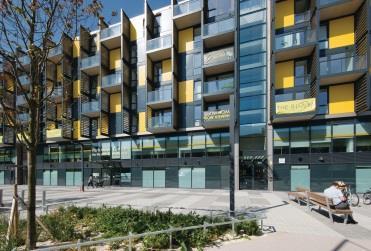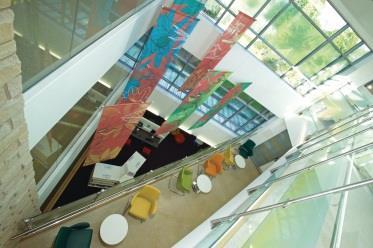Multipurpose community buildings developed by LIFT companies and in collaborations with local authorities in London, the Midlands and the North West show the way for the rest of the country
Parkview Centre for Health and Wellbeing
The Parkview Centre was created by West London Health Partnership, the LIFT company for Ealing, Houslow, and Hammersmith and Fullham councils, which is now owned by the Fulcrum Group and CHP.
When the company was created, Geoff Alltimes was joint chief executive of Hammersmith and Fulham and the primary care trust (now the clinical commissioning group).
‘The development allows people with long term conditions to remain independent and reduce hospital admissions’
After leaving that post, Mr Alltimes became the chair of the company. The company built the Parkview Centre, which comprises four general practices, community health services, 170 affordable apartments, social services from Hammersmith and Fulham, a pharmacy and a supermarket.
Mr Alltimes says of the centre: “More services that previously people had to go to hospital for are all in one building. It’s a convenient and attractive location, in a part of the borough where there is the biggest need for improvement in primary care services.

“There’s a housing development that’s part of it, which is helpful given our need for more housing, and the building is made more affordable given the housing element.
“It enables people, particularly those with long term conditions, to remain independent and reduce hospital admissions.”
Mr Alltimes says it can be difficult to bring together partners to create integrated services, but the rewards are well worth the effort.
With the better care fund and other pressures on local authorities and health services to integrate, many services will reconfigure over the coming years to better meet the needs of patients and service users.

“This model will be replicated all over the country,” Mr Alltimes says.
“It’s the natural progression. It’s just about getting people around the table. We’re increasingly finding that if partners can get together and look at what provides better care to patients and is more cost effective, then people do start to think about what’s in the collective interest, not just the interest of their service.
“More places will follow those models we saw in Torbay and Greenwich, where they’ve created joint teams between social care and community health services.
“In the past we tended to have models where people were expected to fit in, in terms of what we have in buildings, but now we have to start with what the patients need and support that.”
Nottingham City Council’s Clifton Cornerstone
Nottingham City Council has entered into a number of joint service ventures, the first of which is the Clifton Cornerstone, run by the GRT Nottingham LIFT Company.
The centre offers an advice centre and an information and service desk, and houses the social care teams for older people and adults providing occupational therapy, community learning disability services and home care, as well as neighbourhood services and Nottingham City Homes.
True collaboration
The centre also offers two general practices, mental health services, multipurpose diagnostics and treatment clinics, a physiotherapist, rehabilitation, dentistry, health visitors, community nursing and midwifery, sexual health, paediatric clinics, and speech and language therapy.
Graham Chapman, deputy leader with the portfolio resources and neighbourhood regeneration at Nottingham City Council, was closely involved in the development.
“Clifton Cornerstone was the first we did,” he says. “We put housing services in there and a number of health services, plus adult services. It will now also be linked by tram to the city centre and other parts of the estate, so while it is popular now, it will become much more popular still.”
‘Co-location is a great thing to do and has big benefits for the public’
Cllr Chapman says co-location creates the right environment for true collaborative working between different services.
“Co-location is a great thing to do and it has big benefits for the public but the biggest benefit is when the staff start working together. For example, we have employment staff working in the library, and often people come in to the library to use the internet for employment services anyway.
“We’re creating an environment where joint working can happen, and it changes the culture of the staff.”
Salford’s Gateway developments
Salford City Council and NHS Salford Clinical Commissioning Group opened three “gateway” centres over 2008-09. The centres, owned by Salford and the Manchester, Salford and Trafford LIFT Company, represent an investment of £35m, and provide local residents with integrated local authority and primary and community healthcare services.
‘The centres provide residents with integrated local authority and healthcare services’
The centres are situated in Walkden, Pendleton and Eccles. All three existing sites provide a mixture of services, and the convenience of having those services housed under one roof has boosted residents’ access.
Pendleton Gateway provides a library, social care services, and frontline council and third sector services, specialising in children’s services.
Walkden Gateway includes speech and language therapy, physiotherapy, audiology, paediatrics, community nursing and midwives and GPs. These are housed along with library and art therapy services, community meeting rooms, and the local branch of the Citizens Advice Bureau.
Eccles Gateway houses mental health services, physiotherapy, psychology, orthopaedics, minor operations, a café and community meeting rooms.

Proof in the pudding
The results are easy to see. Since Eccles Gateway opened in November 2008, library issues rose from 85,583 per year to 103,965 in 2013. The integration has also drawn new readers into the library services, with new borrowers up from 2,283 in 2008 to 3,322 in 2013. This is despite the national trend of library lending declining year on year.
Use of all three centres has grown steadily since 2009. Walkden has seen footfall rise between 2009 and 2013 from 195,951 per year to 283,225; Eccles’ visitor numbers rose from 184,313 to 270,034; and Pendleton’s from 191,575 to 291,584.
‘The facility is an absolute lifeline for me in maintaining full time work’
All three centres are highly valued by the local community. A respondent to a customer satisfaction survey said Eccles Gateway is “the best thing that has happened to Eccles in the past five years”, while another said it is “a credit to the NHS and Salford City Council”.
On Pendleton Gateway, another resident said: “This facility is an absolute lifeline for me in maintaining full-time work; it is relevant to community and family study.”
Walkden Gateway attracted high praise as well: “The level of service and quality are a significant improvement on anything I have experienced before.”
Facilities management special report: Integrate the estates
- 1
- 2
 Currently reading
Currently readingFacilities management case studies: Positive space




























No comments yet